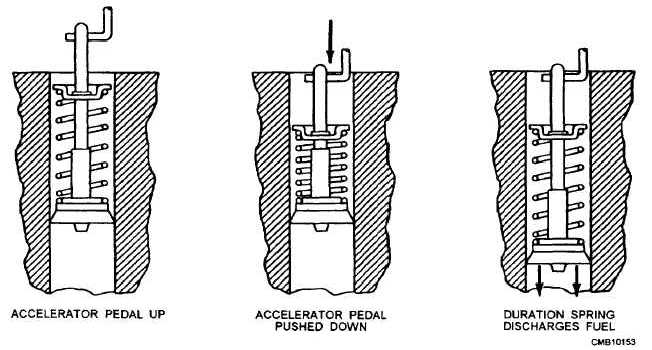The PUMP CHECK BALL only allows fuel to flow into the pump reservoir. It stops fuel from flowing back into the fuel bowl when the pump is actuated.
The PUMP CHECK WEIGHT prevents fuel from being pulled into the air horn by venturi vacuum. Its weight seals the passage to the pump nozzle and prevents fuel siphoning.
The PUMP NOZZLE, also known as the pump jet, has a fixed opening that helps control fuel flow out of the pump. It also guides the fuel stream into the center of the air horn.
The basic operation of the acceleration system is as follows:
The pump piston or diaphragm is pushed down in the pump chamber, as the throttle plate is opened, forcing fuel through the outlet passage.
At the same moment, the pump check ball will seat, keeping fuel from being pumped back into the float bowl.
The pump check weight will be forced off its seat, allowing fuel to pass to the pump discharge nozzle, and then discharged into the carburetor.
The pump piston or diaphragm is raised in the pumping chamber when the throttle plate is closed, causing the pump check weight to seat blocking the outlet passageway.
At the same time, the pump check ball is pulled off its seat and fuel is pulled into the pump chamber from the float bowl.
The pump chamber is filled with fuel and ready for discharge whenever the throttle plate is opened.
The linkage between the accelerator pump and the throttle cannot be solid. If it were, the pump would act as a damper, not allowing the throttle to be opened and closed readily. The linkage activates the pump through a slotted shaft When the throttle is closed, the pump is held by its linkage. When the throttle is open, the pump is activated by being pushed down by a spring that is called a duration spring (fig. 4-24). The tension of the duration spring controls the length of time that the stream of fuel lasts. The spring is calibrated to specific applications. Too much spring pressure will cause fuel to be discharged too quickly, resulting in reduced fuel economy. Too little spring pressure will result in the fuel being discharged too slowly, causing engine hesitation.
High-Speed System
The, high-speed system, also called the main metering system, supplies the engine air-fuel mixture at normal cruising speeds. This system begins to function when the throttle plate is opened wide enough for the venturi action. Air flow through the carburetor must be relatively high for venturi vacuum to draw fuel out of the main discharge tube. The high-speed system

Figure 4-24. - Duration spring.
Continue Reading